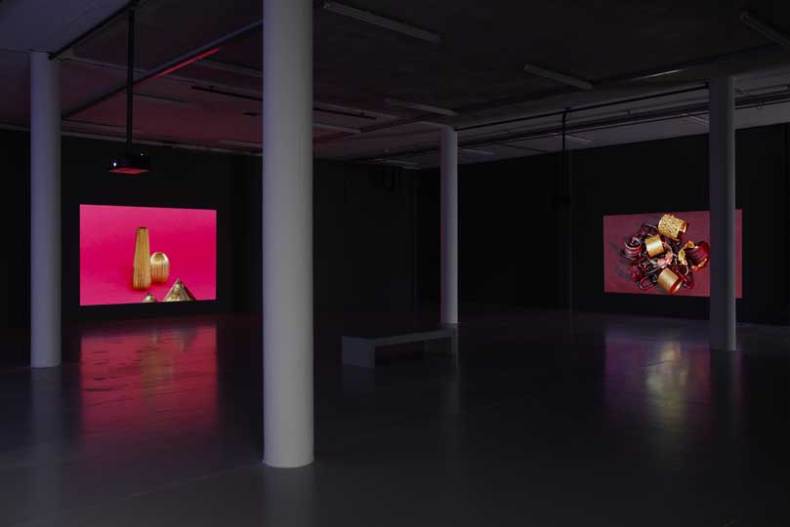Surely there is something of a magpie in all of us: an attraction to gloss, to bright colours and to textures that beg to be both touched and owned. French artist Isabelle Cornaro’s exhibition ‘Témoins oculaires’ (meaning ‘eye witnesses’) at Spike Island (a collaboration with the South London Gallery), probes the surface of such desires, drawing on the connection between the visual and the tactile, on the consumption of objects and the sensual pleasure that this consumption provides. Furthermore, ‘Témoins oculaires’ considers the various material and conceptual shifts that occur when an object is transformed into an image.
The exhibition’s central space is brightly lit and bookended by two highly saturated colour field paintings, worked directly on to the gallery walls. Connected to street art through their use of acrylic spray paint, which is built up in layers, these works also bear traces of abstract modernism in both their scale and form. On closer inspection the tiny dots of pigment that make up Reproductions (# 1, purple) (2010/15) and Reproductions (# 3, red) (2010/15) also resemble pixels – the building blocks of digital and printed images. It transpires that these paintings are not ‘original’ paintings at all, but Cornaro’s own reproductions of stills from her films. Although composed of numerous layers of paint, the surface of these two paintings are as smooth and flat as a digital projection.

Installation view, including ‘Metronomie’ (2014; left) and ‘Amplifications’ (2014; right) Image courtesy Stuart Whipps (photographer) and Spike Island. All works courtesy of the artist and galleries Balice Hertling, Hannah Hoffman and Francesca Pia
Cornaro’s film works Metronomie, Amplifications and Choses (all 2014), from which her paintings are derived, are installed in a darkened room adjacent to the main gallery. The objects used in Choses are set within oozing landscapes of paint that drip and flow in yellow, purple, green, pink and blue. The films use a variety of cinematic techniques: fast cuts, tracking and close-ups that slide over random objects the artist has collected or inherited, such as coins, golden bangles, glass vessels, stone heads, heavy dark chains, crystals and lipstick cases. Transferred from tactile objects into two-dimensional projections, the process animates but also alters these objects into something fleeting, desirable and unobtainable.
And yet the ‘real’ objects – and not just their image – are included within installations elsewhere in the gallery. Here they appear smaller, more vulnerable to damage and theft. But are they authentic, original works? The objects are mass-produced and many are facsimiles of older designs. Cornaro’s objects are positioned on large, meticulously built structures made on-site at Spike Island, and are clad in gold mirror Perspex, plastic laminate, painted glass and birch plywood. Serving as plinths, stage-sets and sculptures in their own right, these elegant forms are designed to accentuate the textures of the objects on show.

Scenes #4 (detail; 2015), Isabelle Cornao Image courtesy Stuart Whipps (photographer) and Spike Island. All works courtesy of the artist and galleries Balice Hertling, Hannah Hoffman and Francesca Pia
Another film, Floues et colorées (2010), shows the application of Cornaro’s spray paint in action. Soft clouds of powdery colour float and stick to the surface in a kind of painting-turned-film. Again, the artist explores the process of translation within her work, for not only has a painting become a film, but her 16mm film is now a digital version of itself. The unique properties of 16mm film makes this transition all the more pronounced.
It is, perhaps, Cornaro’s film works which most effectively negotiate the terrains of translation, reproduction and consumption, precisely because they remain elusive. The best part of consumption is often the anticipation.
‘Isabelle Cornaro: Témoins oculaires’ runs at Spike Island, Bristol until 29 March; ‘Paysage avec poussin’ runs at South London Gallery until 5 April.














![Masterpiece [Re]discovery 2022. Photo: Ben Fisher Photography, courtesy of Masterpiece London](http://zephr.apollo-magazine.com/wp-content/uploads/2022/07/MPL2022_4263.jpg)
‘Like landscape, his objects seem to breathe’: Gordon Baldwin (1932–2025)